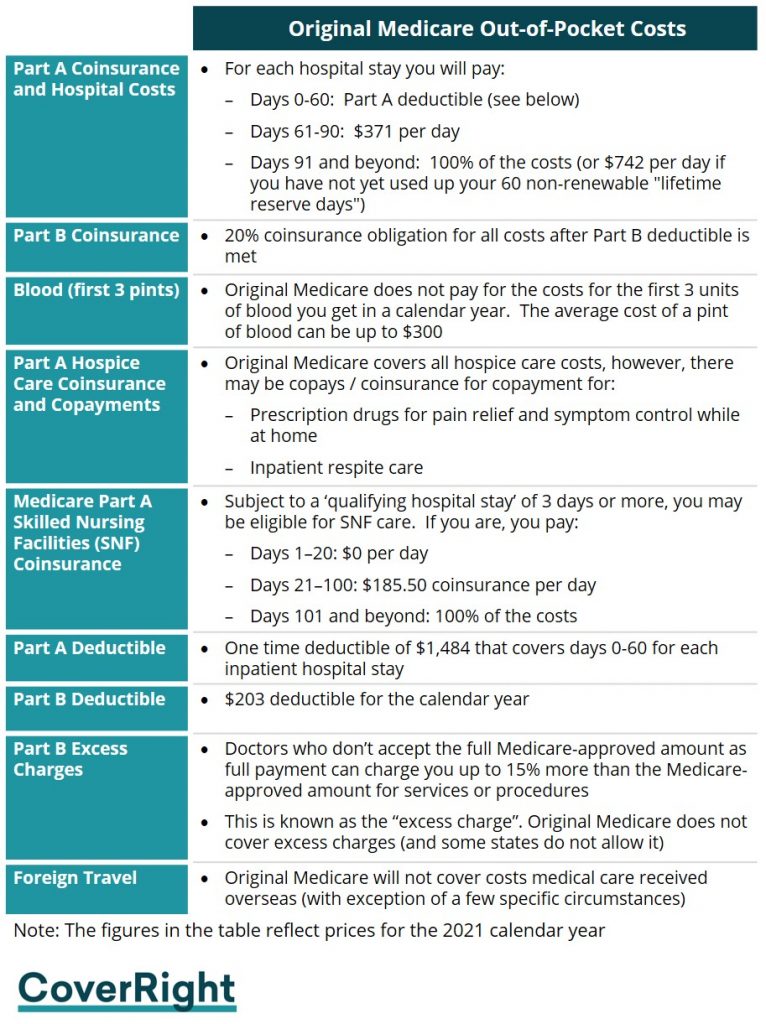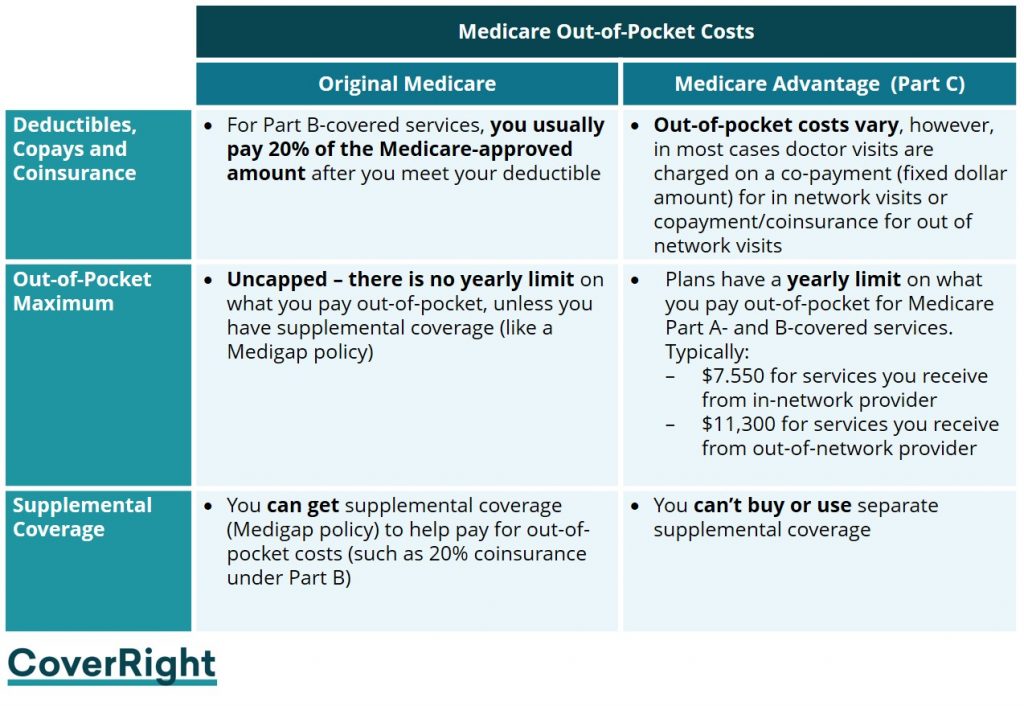Why You Probably Need More than Original Medicare to Cover Your Medical and Healthcare Costs
People who have just signed up for Medicare feel great. Some of them signed up at the same time they enrolled in Social Security at age 65. Others signed up during their initial enrollment period. (That begins three months before the month they turned 65, includes the month they turn 65, and then runs the three months that follow – all in all, seven months.)
Wow, they feel a sense of relief! They’re covered! But in the days following that brief period of joy, they start to worry about a number of issues they weren’t thinking about before, like these . . .
- “Can I still see my current primary care provider, or do I have to change?”
- “If I go to the emergency room, will Medicare cover that?”
- “Will Medicare pay for the dental implant that I think I am going to need?”
- “Will the medications I am now taking be covered . . . will I have a copay?”
- “If I get a ramp installed to help me get into and out of my house, will Medicare pay for that, or at least for part of it?”
Questions, questions. And suddenly that feeling of joyous freedom starts to fade. But don’t worry! In today’s article, we are going to explain how you can make sure you are getting – and will continue to get – the coverage you need.
The Big Picture
Before we get into the nuts and bolts, let’s give you a quick overview of what you are going to have to do to make sure you are getting the coverage you want and need . . .
You are going to investigate adding one of two kinds of extra coverage – Medicare Supplement (also called Medigap) or Medicare Advantage – to get the coverage you want and need.
That’s the overview. And here’s the information you need.
First of All, Let’s Review Original Medicare
Original Medicare is the government’s default health coverage and refers to the combination of Part A (Hospital Insurance) and Part B (Medical Insurance). Under Original Medicare, the federal government provides health insurance to you directly.
Most people are eligible for premium-free Part A coverage, however, everyone who enrolls in Part B is required to pay the Part B standard premium of $170.10 in 2022 (this amount may be higher, depending on your income; the higher your income, the more you may have to pay every month). Bear in mind, that you will also be responsible for out-of-pocket costs such as deductibles, copays, and coinsurance expenses.
If you are over 65 and are a U.S. citizen, or a permanent resident who has been living in the U.S. constantly for five years, you are eligible for Medicare coverage and will be automatically enrolled in Original Medicare if you have already started collecting Social Security by the time you’re 65. If you aren’t collecting Social Security you can enroll by contacting the Social Security Administration.
What Are the “‘Gaps” in Original Medicare?
Original Medicare helps to cover your costs for hospital and medical services, but it does not cover all the costs. Under both Part A and Part B, you will still be responsible for deductibles, copays, and coinsurance payments. These are known as out-of-pocket costs and are the ‘gaps’ that are often referred to when talking about Medigap.
Below is a summary of some of the key Original Medicare out-of-pocket costs.

What Is Medicare Supplement Insurance (Also Called Medigap)?
Medigap (also known as Medicare Supplement insurance) is sold by private insurance companies and is designed to help pay for the out-of-pocket health care costs (or ‘gaps’) that your Original Medicare does not cover.
Around 24% of all Medicare beneficiaries (or about 15 million people) have chosen to purchase a Medigap plan.
What Are the Different Types of Medicare Supplement (Medigap) Plans?
In total, there are 10 kinds of Medigap plans available: Plans A, B, C, D, F, G, K, L, M, and N. Each plan provides a different level of coverage which is standardized and determined by the government. For example, Plan G from Company A provides the same coverage as Plan G from Company B.
Because Medigap plans are standardized, the only differences when comparing the same plan across different companies are the price and the insurer’s reputation.
High Deductible and Cost-Share Medigap Plans
Plan F (no longer available to first-time enrollees) and Plan G are the most comprehensive plans. With these plans, your costs are largely limited to the plan’s monthly premium. These plans cover close to 100% of all out-of-pocket costs. Because of this, Plan F and G generally will be the most expensive plans.
In some states, there are ‘high-deductible’ versions of Plan F and G. With this option, you must pay for out-of-pocket costs (coinsurance, copayments, and deductibles) up to a deductible amount of $2,490 before the policy helps to pay. These plans enable you to access the more comprehensive coverage of Plan F and G but typically at a lower premium as you take on a higher burden of costs upfront.
Plans K and L are cost-sharing plans that help pay a portion of your out-of-pocket costs. Once you reach an annual out-of-pocket cost of $6,620 and $3,310 respectively, as well as your yearly Part B deductible ($233 in 2022), these Medigap plans will pay for 100% of covered services for the rest of the calendar year. Similar to high deductible Plan F and Plan G, your premiums will generally be lower because you take on more out-of-pocket costs upfront.
Do You Have Special Health Care Needs? Or Are You Worried About Future Health Care Concerns?
Do you have type 2 diabetes or a heart condition that requires regular monitoring or possible care in the future? If so, you will definitely want additional coverage. Without it, Original Medicare will eventually cost you more than you realize.
So explore what each plan will and won’t cover and how that coverage will be delivered.
Remember, if you are concerned about special medical issues, you might be best off with a Medicare Supplement plan now, even if that means paying a little more today for coverage you may need later. Your other option will be a Medicare Advantage plan which delivers coverage in a different model. Don’t worry. This article will explain what you should be thinking about.
What Supplement (Medigap) Plan Should You Enroll In?
If you are thinking of a Medigap plan, the plan you choose will depend on your health and financial situation. As mentioned above, one of the benefits of a Medigap plan is that it improves the predictability of your healthcare expenses by shifting the burden of out-of-pocket costs to the insurer in return for a monthly premium.
Given this, the plan you pick should consider:
- Monthly Premium: Your monthly budget and ability to continuously pay the monthly premium to keep a policy in effect.
- Usage of Medical Services: Your expected usage of medical services (inpatient and outpatient), including the risk that any current, hereditary, or other conditions could play a risk in increased usage of medical services in the future. If you have a higher usage rate you may want more comprehensive coverage.
For example, if the quoted premium for a Plan G is $150 per month ($1,800 per year). Your standard Medicare Part B premium is $170.10 per month in 2022 ($2,041 per year). Plan G covers all costs except for the Part B deductible of $233. In this example, the maximum annual out-of-pocket cost you will pay is: $4,074 ($1,800 + $2,041 + $233). If you expect your annual medical costs without Medigap to be higher than this (or there is a reasonable risk that it may be higher) then a Plan G may be a good way to manage your cost.
You will need to do a similar analysis for each plan and balance the risk of paying out-of-pocket costs for using medical services by eliminating that risk by paying a monthly premium and having the insurer take that risk.
You can read our article on the most popular Medigap plans to find out what other Medicare beneficiaries are buying.
When Can You Enroll in a Supplement (Medigap) Plan?
If you are eligible for Medicare, you are allowed to apply for a Medigap plan at any time. However, with the exception of certain specific situations, federal law does not require insurance companies to sell you a Medigap plan.
In other words, outside of specific situations, insurance companies can medically underwrite you, decide to decline coverage, or sell you a policy with a higher premium and/or make you wait for coverage of pre-existing conditions for up to six months.
Medicare Supplement Open Enrollment Period (MS-OEP)
The key exception to that rule is your MS-OEP which is the six-month period that begins right after you enroll in Medicare Part B. During the MS-OEP, Medigap companies:
- must sell you a policy without asking medical questions
- cannot deny you coverage
- cannot charge you an additional premium for coverage because of your medical history
This is known as a ‘guaranteed issue.’ For most people this will happen when you turn 65, however, some people may delay enrollment into Part B while they are still working.
In addition, during your MS-OEP, if you previously had at least six months of continuous prior ‘creditable’ coverage and did not have a break in coverage of more than 63 days, the Medigap plan cannot impose a waiting period for pre-existing conditions. ‘Creditable coverage’ includes specific types of group health insurance (from an employer) that provide equal or better coverage than Medicare (check with your provider to find out if your plan is considered ‘creditable’).
Bear in mind, the MS-OEP only happens once and does not renew once it has lapsed. This is the best time to purchase a Medigap policy if you want one. If you apply for Medigap coverage after your MS-OEP, there is typically no guarantee that an insurance company will sell you a Medigap policy. Some states may have other certain guaranteed issue periods outside of MS-OEP.
What About Medicare Advantage Plans?
Now let’s go on to consider Medicare Advantage plans, the second kind of extra coverage you can add to Original Medicare.
What Are Medicare Advantage Plans?
Medicare Advantage (also known as ‘Part C’ coverage), another kind of plan you could consider, is provided by private health insurance companies who are contracted with the federal government to deliver you Medicare. Under Medicare Advantage, the government provides your health insurance indirectly by paying Medicare Advantage plan providers a monthly payment for your health insurance.
Medicare Advantage is a bundled ‘all-in-one’ alternate solution to Original Medicare and is required by law to at least provide the same coverage you would receive for Part A and Part B insurance under Original Medicare. Medicare Advantage often includes additional extra benefits such as Part D prescription drug coverage, dental, vision, and hearing.
Everyone who is eligible for Original Medicare is also eligible for Medicare Advantage. However, once you enroll in a Medicare Advantage plan you no longer receive coverage through Original Medicare and must receive care in accordance with your plan provider’s policies.
You will still need to pay your standard Part B premium if you are in a Medicare Advantage plan. You may also be required to pay an additional premium to the plan provider depending on the plan you choose.
How do these plans work? You will receive comprehensive health care with Medicare Advantage plans.
Aside from getting Part A (hospitalization) and Part B (medical), as you do in traditional Medicare, Part C plans may offer additional bundled benefits that can include:
- Dental
- Eye exams
- Hearing tests and devices
- Fitness memberships like Silver Sneakers
- Chiropractic care
- Home health care
- Prescription drug coverage
- Telehealth services
Different Kinds of Medicare Advantage Plans You Should Understand
Part C plans are categorized as follows:
- Health Maintenance Organization (HMO) plans have a network of doctors and require referrals to see specialists.
- Preferred Provider Organization (PPO) plans allow in-network and out-of-network consultations at different rates.
- Private Fee-for-Service (PFFS) plans are for those who need maximum flexibility with health providers.
- Special Needs Plans (SNP) help people who meet special criteria, such as having both Medicare and Medicaid, living in an institution (like a nursing home), or having chronic conditions.
- Medical Savings Accounts (MSA) are ideal for those who prefer savings accounts with high-deductible health plans.
The third benefit of some Medicare Advantage plans is that you can generate long-term savings. For example, many plans are zero-dollar premium plans. You pay nothing for these plans on top of your Part B premium each month. There are also Medicare Advantage plans with inexpensive deductibles. Some plans also charge reduced fees for laboratory services and medical equipment.
Part C plans have a maximum annual limit on out-of-pocket expenses. This means you stop spending out-of-pocket after your costs have reached the maximum limit each year. When this happens, your Medicare Advantage plan pays the rest of the cost of covered services.
Lastly, you may have coordinated and personalized health care with Part C plans. Under the plan’s network, you may have access to a team of medical experts who can coordinate your treatment if you require medical services.
Now that we’ve covered the pros of Medicare Advantage plans, let’s discuss some of the downsides of these plans.
What Are the Disadvantages of Medicare Advantage Plans?
Knowing the limitations of these plans will help to give you a better understanding of whether Medicare Advantage is right for you.
The first downsides are the restrictions imposed by some Medicare Advantage plans. Here are some examples:
- You can only visit doctors and treatment facilities within your plan’s network, under certain plan types.
- Going outside the network, when available, typically means facing higher premiums, copayments, and deductibles.
- You may have to change doctors in case of plan network changes.
- Part C plans require pre-authorization or referrals before you can visit specialists.
The second disadvantage of Part C is that there may not be any plans offered in your location.
- You can only join Part C plans within your service area or state. Therefore, you need to check the plans offered near your location or residence.
- Many who live in rural areas often opt for only Original Medicare because it is difficult to reach doctors within the networks attached to Medicare Advantage plans they can obtain.
Still another disadvantage of Part C plans is the extra costs. Although there are long-term savings with MA plans, specialist and hospital copayments and costs for other services can add up to large sums across a year. Plus, the annual out-of-pocket limit does not apply to prescription drugs and other perks.
Therefore, depending on your case, a Medicare Advantage plan may turn out to be more expensive.
What Does Medicare Advantage Cover, Compared to Original Medicare?
Health insurance companies that provide Medicare Advantage plans are required by law to deliver at least the same coverage as Part A and Part B insurance that you receive under Original Medicare.
However, there are some differences to consider when you are deciding whether you want to receive your coverage through Original Medicare versus Medicare Advantage:
This Chart Can Help You Make the Right Decision

Get Expert Guidance from A CoverRight Medicare Specialist
The best advice is to speak with someone who doesn’t have a motive in your decision for one plan vs. another. You want someone who is looking out for your best interests and who will get you the best Medicare coverage possible.
———————————–
CoverRight is on a mission to make the Medicare plan selection process easy to understand. We are here to help you find the best Medicare plans suited to your specific situation. Try our self-guided Medicare quiz to see for yourself.
Free Medicare Resources
Recent Posts
What You Need to Know When Comparing and Shopping for a Medicare Plan







